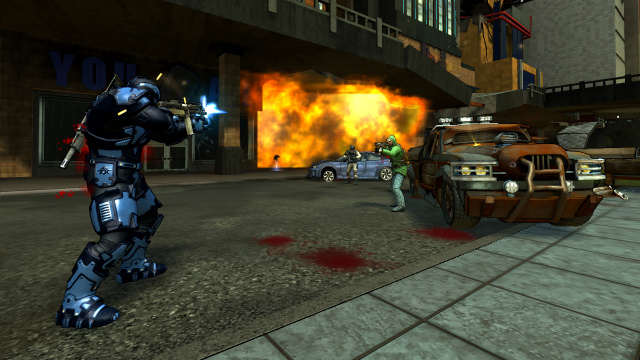Dead Rising 2: Case Zero provides players with an idea of what to expect from the sequel to the 2006 Xbox 360 exclusive Dead Rising and introduces new protagonist Chuck Greene. This demo-cum-prequel also reassures fans that almost everything they loved about the first game is intact and the tense, time-constrained gameplay experience has not been watered down.
Chuck Greene is a motorcycle stuntman with a big problem. His daughter Katey has been infected with a virus that will turn her into a zombie unless she gets a shot of a drug called Zombrex every 12 hours. We are introduced to Chuck and Katey as they pull into a gas station in the small desert town of Still Creek in search of supplies.
The pair ends up stranded in the zombie-riddled town after their truck is stolen. Chuck needs to find Katey’s next dose of Zombrex and get her out of town before the military arrives and invariably takes her to a quarantine zone.
Players will encounter a number of missions in Dead Rising 2: Case Zero. Chuck will be able to collect important items, escort survivors to safety or simply slaughter as many zombies as he can during any given play through.
Like the first game, a varied set of achievements will have most playing through the brief 90 minute campaign several times. It’s next to impossible to do everything in one run because of severe time constraints. Players will have to manage their time and resources and make decisions about what is most important to them during a playthrough.
Should you reach any one of several endings or succumb to the zombies, your experience and money will carry over to your next playthrough, meaning Chuck will be stronger from the get-go and certain tasks will be easier to complete.
Chuck has a level cap of five in Dead Rising 2: Case Zero, but any experience and level-up bonuses you receive will carry over to the full Dead Rising 2 game. This self-earned “head start” is an excellent bonus for fans that plan on purchasing the full game for Xbox 360.
Almost everything in Still Creek can be used as a weapon, from newspapers and handbags to swords and guns; all of which do varying degrees of damage to the ever present zombie horde. Chuck has a rather limited inventory space that shares weapons and health-replenishing food items. Players must manage this space effectively to survive, let alone succeed.
A new weapon combination system essentially replaces the photography system found in the original Dead Rising. This system allows Chuck to combine items he finds around Still Creek—such as a shotgun and a pitchfork—to create more powerful zombie killing tools; many of which have hilariously gruesome effects.
Using combined weapons earns Chuck extra experience and nets players Combo or Scratch cards that often provide additional bonuses like double experience. Any cards earned in Dead Rising 2: Case Zero will carry over to the full game.
The controls have been made more player-friendly this time around and should feel comfortable to anyone that plays third-person action games. Jump, attack and action commands are mapped to the face buttons, triggers are used for aiming and shooting and the bumpers cycle through your inventory.
Control is good for the most part, but platforming to access higher ground can be pretty clunky and often requires pinpoint timing. A finicky camera can also create problems on occasion.
Dead Rising 2: Case Zero can feel sluggish in general because of a less than optimal frame rate that struggles to maintain 30fps most of the time. In fairness, there are a greater number and variety of zombies on screen than in Dead Rising, but the slowdown is quite noticeable and consistent.
The game looks pretty good overall and the town of Still Creek is very detailed, but textures can be quite blurry up close and there are very prevalent instances of tearing and clipping. The excellent lighting engine of Dead Rising seems conspicuously absent as well, likely because of a game engine change.
It’s safe to say that outsourced, Canadian developer Blue Castle Games gets Dead Rising. They managed to improve on a cult-classic experience in many ways without pandering to those that found the original too difficult. The only concession they made was the addition of two extra save slots, though players can still “save themselves into a corner” rather easily.
Dead Rising 2: Caze Zero presents a more “human” and meaningful narrative than the original and provides a unique experience separate from the two main games. By the time I collected all 200 achievement points, I’d spent at least five hours with the game. Tremendous value for both existing fans and those new to the series.
Positives:
+ High Replay Value, Lots of Content for $5.
+ Tense, Time-Constrained Gameplay is Intact
+ Weapon Combo System is Very Fun
+ Good Narrative, Writing and Voice Acting
Negatives:
– Frame Rate, Tearing and Clipping Issues
– Load Times are Excessive



 Picross 3D offers five difficulty modes which get progressively unlocked. In beginner mode a tutorial shows players all the ropes. However, there is no way to skip this section to immediately start solving puzzles. Those returning to the Picross series or starting the game a second time may find this feature annoying.
Picross 3D offers five difficulty modes which get progressively unlocked. In beginner mode a tutorial shows players all the ropes. However, there is no way to skip this section to immediately start solving puzzles. Those returning to the Picross series or starting the game a second time may find this feature annoying.